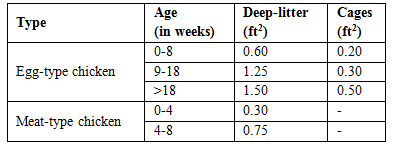Layer Management
Points to be considered during layer management are,
- Proper cleaning and disinfection of layer house.
- Provide proper floor space, feeding space and watering space both in deep-litter and cage system
- In deep-litter system, floor space of 2 sq.ft. per bird and feeding space of 5” per bird are provided
- In cage system 4 birds/box of 18” x 15” cage floor space is provided (0.46 sq. ft per bird)
- 6 feet linear feeder can be used for every 30 layers or 18” diameter circular feeder of 4-5 no for every 100 birds.
- Provide 18” diameter plastic waterer of 2 numbers for every 100 birds.
- Spread litter material, in case of deep-litter system up to 6” thickness.
- Arrange feeder and waterer in the poultry house to the height of birds’ back.
- Grill size may be changed according to the size of the birds head.
- Provide nest box for every 5 layers about a week before the first egg is laid.
- There are three types of nest: 1) Individual nest – One nest box is sufficient for 4-5 birds. 2) Community nest – This will accommodate 50-60 birds. 3) Trap nest – This will accommodate 1 bird at a time ad is used for academic and breeding studies.
- The nest should be provided with litter material. The litter material has to be replaced at least once in a week to prevent contamination of the eggs. During night hours the nest should be closed to prevent sitting of birds in the nest.
- In deep-litter system, the litter material should be racked in the evening daily after egg collection is over. The litter should be treated chemically at least once in a month or whenever necessary in case of wet litter problem to prevent ammonia emission in the house.
- Provide 16 hours light during laying period.
- Provide well-balanced layer mash. Phase feeding may be followed for layers according to age, level of production and climatic factors. The average feed consumption during laying period ranges from 100-110 gram.
- Feed consumption during winter increases and during summer, feed consumption decreases. Summer and winter management should be followed for better flock percentages.
- Deworming should be done regularly at an interval of 6-8 weeks depending on the worm load, especially when reared under deep-litter system.
- Collect the eggs at least 5 times a day in deep-litter system and twice a day in cage system.
- Cull the unproductive layers regularly.
- Broody hen may be separated and this broodiness may be eliminated by,
- Providing diet containing more protein, vitamin and minerals.
- Light may be provided through out night.
- Birds may be placed in cages
- Birds may be subjected to stress
- Liver stimulant may be provided.

Vaccination schedule for layers

Takes:
After week of fowl pox vaccination, an inflamed area is seen at the site of vaccination. It is called as takes.
TOP

